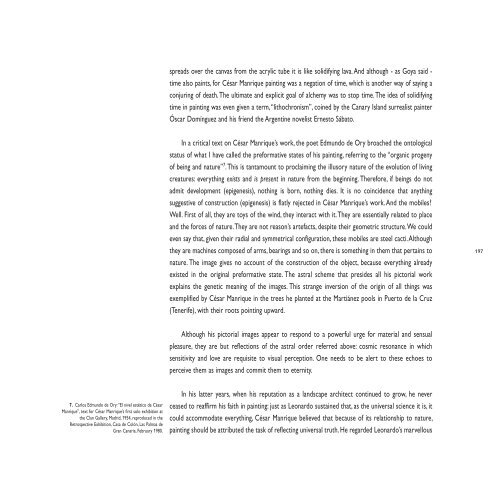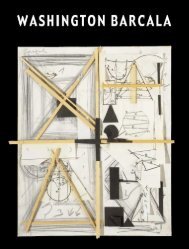VERSIÓN INGLESA ENGLISH VERSION - Fundación César Manrique
VERSIÓN INGLESA ENGLISH VERSION - Fundación César Manrique
VERSIÓN INGLESA ENGLISH VERSION - Fundación César Manrique
Create successful ePaper yourself
Turn your PDF publications into a flip-book with our unique Google optimized e-Paper software.
7. Carlos Edmundo de Ory: “El nivel estético de <strong>César</strong><br />
<strong>Manrique</strong>”, text for <strong>César</strong> <strong>Manrique</strong>’s first solo exhibition at<br />
the Clan Gallery, Madrid, 1954, reproduced in the<br />
Retrospective Exhibition, Casa de Colón, Las Palmas de<br />
Gran Canaria, February 1980.<br />
spreads over the canvas from the acrylic tube it is like solidifying lava. And although - as Goya said -<br />
time also paints, for <strong>César</strong> <strong>Manrique</strong> painting was a negation of time, which is another way of saying a<br />
conjuring of death. The ultimate and explicit goal of alchemy was to stop time. The idea of solidifying<br />
time in painting was even given a term, “lithochronism”, coined by the Canary Island surrealist painter<br />
Óscar Domínguez and his friend the Argentine novelist Ernesto Sábato.<br />
In a critical text on <strong>César</strong> <strong>Manrique</strong>’s work, the poet Edmundo de Ory broached the ontological<br />
status of what I have called the preformative states of his painting, referring to the “organic progeny<br />
of being and nature” 7 . This is tantamount to proclaiming the illusory nature of the evolution of living<br />
creatures: everything exists and is present in nature from the beginning. Therefore, if beings do not<br />
admit development (epigenesis), nothing is born, nothing dies. It is no coincidence that anything<br />
suggestive of construction (epigenesis) is flatly rejected in <strong>César</strong> <strong>Manrique</strong>’s work. And the mobiles?<br />
Well. First of all, they are toys of the wind, they interact with it. They are essentially related to place<br />
and the forces of nature. They are not reason’s artefacts, despite their geometric structure. We could<br />
even say that, given their radial and symmetrical configuration, these mobiles are steel cacti. Although<br />
they are machines composed of arms, bearings and so on, there is something in them that pertains to<br />
nature. The image gives no account of the construction of the object, because everything already<br />
existed in the original preformative state. The astral scheme that presides all his pictorial work<br />
explains the genetic meaning of the images. This strange inversion of the origin of all things was<br />
exemplified by <strong>César</strong> <strong>Manrique</strong> in the trees he planted at the Martiánez pools in Puerto de la Cruz<br />
(Tenerife), with their roots pointing upward.<br />
Although his pictorial images appear to respond to a powerful urge for material and sensual<br />
pleasure, they are but reflections of the astral order referred above: cosmic resonance in which<br />
sensitivity and love are requisite to visual perception. One needs to be alert to these echoes to<br />
perceive them as images and commit them to eternity.<br />
In his latter years, when his reputation as a landscape architect continued to grow, he never<br />
ceased to reaffirm his faith in painting: just as Leonardo sustained that, as the universal science it is, it<br />
could accommodate everything, <strong>César</strong> <strong>Manrique</strong> believed that because of its relationship to nature,<br />
painting should be attributed the task of reflecting universal truth. He regarded Leonardo’s marvellous<br />
197
















![Becas y premios de la Fundación César Manrique [1997-2006]](https://img.yumpu.com/20766851/1/184x260/becas-y-premios-de-la-fundacion-cesar-manrique-1997-2006.jpg?quality=85)
